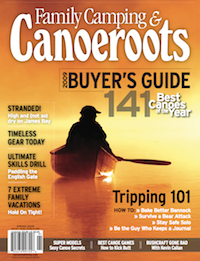I had no interest in canoeing when my father gave me a copy of Don Starkell’s Paddle to the Amazon on my 13th birthday. Two weeks later, I had finished Starkell’s diary of his father-and-sons canoe trip across the Americas, purged the public library of all its canoe titles and convinced my father to take me on my first overnighter. As we drove to the river, a stout rented fibreglass canoe tied to the roof of my dad’s Jetta, Starkell’s journal dominated my imagination. I was psyched for pirates, mutiny and towering waves—maybe even starvation and long, stringy hair.
The best trip journals are part personal reflection, part record of information
None of that came to pass. I know this because I kept a journal myself. The penmanship is sloppy, and some trains of thought never pull into the station, but all I have to do is re-read it to trip again for the first time.
It’s because of that journal that I remember that first canoe trip better than my last. Memories of the nine summers I’ve spent as a wilderness guide are more fleeting. My logbook from those years is mundane and impersonal. I recorded campsites, weather, menu and morale.
The only things that seemed to warrant more documentation were scraped knees and bee stings. Strings of campsites and thunderstorms replaced feelings about what really happened.
That’s not to say that a matter-of-fact trip log doesn’t have its place. It depends why you want to put pen to paper. A trip journal can be one of two things—a personal reflection, or a record of information. But the best are a combination of both—like Starkell’s day-to-day deliberations of paddling nearly 20,000 kilometres from Winnipeg to the Amazon. According to editor Charles Wilkins, Paddle to the Amazon began as a million-word, foot-high stack of trip notes. Pared down, it became the stuff of legends, a story of high adventure, hardship and love.
The feel-good reason for taking time to write in a journal is that the very activity forces you to slow down and appreciate where you are. It also helps you understand why you’ve chosen to escape society for a time. The practical part is that a journal reinforces your memory and makes things easier if you decide to go back for a second trip, or share your notes with friends.
I still have the yellow Hilroy notebook that was my first journal: Saturday, June 4. … I broke my paddle on the third rapid and I had to use the blade part like a ping-pong racket for the rest of the day. Dad said we should’ve brought along one of my broken goalie sticks as a spare.
Perhaps not a bestseller on par with Starkell’s, but well worth recording.
You need not aspire to win a Pulitzer Prize to keep a journal:
• Discipline is paramount. Don’t miss a day, or you’ll miss the next one too.
• Keep your notebook accessible in a Zip-loc bag so you can grab it throughout the day before your thoughts leave you.
• Voice recorders work, but only if you trust yourself to transcribe later.
• Engage the group and elicit material by conducting daily polls or surveys relating to the trip.
• Awarding a “quote of the day” is a good way to engage your partners and mark each day’s most worthy moments.
• Don’t leave the journal entry until night when you are tired and need to hang the food. Take regular breaks on the water to write as your canoe spins in the wind.
• Dirty paper and pens don’t mix; use a trusty pencil.
• A group journal in which each trip member is responsible for specific days adds variety to the manuscript and lets you learn from other people’s writing style.
• Hold yourself to a higher standard than just recording the weather and menu for the day. Years later, you’ll be more interested in the sounds and feelings of paddling a class III rapid, rather than the line you took through it.

This article first appeared in the Spring 2009 issue of Canoeroots Magazine.


